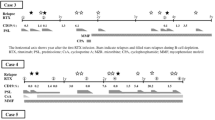Abstract
Background
The therapeutic efficacy of B cell–depleting anti-CD20 treatment in both pediatric and adult steroid-sensitive nephrotic syndromes (SSNS) suggests that B cells play a pathogenic role in the disease. In adults with minimal change disease (MCD), only circulating plasmablasts are increased during the active phase of the disease, among B cell subsets. These cells have not been studied yet in children with SSNS.
Methods
We retrospectively quantified by flow cytometry analysis circulating plasmablasts in 107 pediatric patients with SSNS (51 at disease onset, 27 during relapse, and 29 in remission). Data were compared with an equal number of age- and sex-matched healthy donors (HD).
Results
Circulating plasmablast levels, expressed as percentage of total CD19+ B cells or as percentage of total lymphocytes, were normal in all SSNS subgroups, compared to HD. Patients in remission had significantly fewer circulating plasmablasts compared to patients at disease onset. No significant correlation was observed between plasmablast levels and proteinuria or serum proteins, at onset. Treatment with prednisone and mycophenolate mofetil significantly reduced circulating levels of plasmablasts, unlike treatment with prednisone and calcineurin inhibitors.
Conclusions
The B cell phenotype of children with SSNS differs from that of adults with MCD. This may justify different therapeutic approaches.

Similar content being viewed by others
Data availability
The datasets generated during and/or analyzed during the current study are available from the corresponding author on reasonable request.
Code availability
Not applicable.
References
Ravani P, Bonanni A, Rossi R, Caridi G, Ghiggeri GM (2016) Anti-CD20 Antibodies for idiopathic nephrotic syndrome in children. Clin J Am Soc Nephrol 11:710–720. https://doi.org/10.2215/CJN.08500815
Gauckler P, Shin JI, Alberici F, Audard V, Bruchfeld A, Busch M, Cheung CK, Crnogorac M, Delbarba E, Eller K, Faguer S, Galesic K, Griffin S, van den Hoogen MWF, Hrušková Z, Jeyabalan A, Karras A, King C, Kohli HS, Mayer G, Maas R, Muto M, Moiseev S, Odler B, Pepper RJ, Quintana LF, Radhakrishnan J, Ramachandran R, Salama AD, Schönermarck U, Segelmark M, Smith L, Tesař V, Wetzels J, Willcocks L, Windpessl M, Zand L, Zonozi R, Kronbichler A; RITERM study group (2020) Rituximab in adult minimal change disease and focal segmental glomerulosclerosis - what is known and what is still unknown? Autoimmun Rev 19:102671. https://doi.org/10.1016/j.autrev.2020.102671
Lapillonne H, Leclerc A, Ulinski T, Balu L, Garnier A, Dereuddre-Bosquet N, Watier H, Schlageter MH, Deschenes G (2008) Stem cell mobilization in idiopathic steroid-sensitive nephrotic syndrome. Pediatr Nephrol 23:1251–1256. https://doi.org/10.1007/s00467-008-0793-2
Colucci M, Carsetti R, Cascioli S, Serafinelli J, Emma F, Vivarelli M (2019) B cell phenotype in pediatric idiopathic nephrotic syndrome. Pediatr Nephrol 34:177–181. https://doi.org/10.1007/s00467-018-4095-z
Ling C, Wang X, Chen Z, Fan J, Meng Q, Zhou N, Sun Q, Hua L, Gui J, Liu X (2019) Altered b-lymphocyte homeostasis in idiopathic nephrotic syndrome. Front Pediatr 7:377. https://doi.org/10.3389/fped.2019.00377
Oniszczuk J, Beldi-Ferchiou A, Audureau E, Azzaoui I, Molinier-Frenkel V, Frontera V, Karras A, Moktefi A, Pillebout E, Zaidan M, El Karoui K, Delfau-Larue MH, Hénique C, Ollero M, Sahali D, Mahévas M, Audard V (2021) Circulating plasmablasts and high level of BAFF are hallmarks of minimal change nephrotic syndrome in adults. Nephrol Dial Transplant 36:609–617. https://doi.org/10.1093/ndt/gfaa279
Schrezenmeier E, Jayne D, Dörner T (2018) Targeting b cells and plasma cells in glomerular diseases: translational perspectives. J Am Soc Nephrol 29:741–758. https://doi.org/10.1681/ASN.2017040367
Vivarelli M, Massella L, Ruggiero B, Emma F (2017) Minimal change disease. Clin J Am Soc Nephrol 12:332–345. https://doi.org/10.2215/CJN.05000516
Colucci M, Carsetti R, Cascioli S, Casiraghi F, Perna A, Rava L, Ruggiero B, Emma F, Vivarelli M (2016) B cell reconstitution after rituximab treatment in idiopathic nephrotic syndrome. J Am Soc Nephrol 27:1811–1822. https://doi.org/10.1681/ASN.2015050523
Bhatia D, Sinha A, Hari P, Sopory S et al (2018) Rituximab modulates T- and B-lymphocyte subsets and urinary CD80 excretion in patients with steroid-dependent nephrotic syndrome. Pediatr Res 84:520–526. https://doi.org/10.1038/s41390-018-0088-7
De Bruyne R, Bogaert D, De Ruyck N, Lambrecht BN, Van Winckel M, Gevaert P, Dullaers M (2015) Calcineurin inhibitors dampen humoral immunity by acting directly on naive B cells. Clin Exp Immunol 180:542–550. https://doi.org/10.1111/cei.12604
Smulski CR, Eibel H (2018) BAFF and BAFF-receptor in B cell selection and survival. Front Immunol 9:2285. https://doi.org/10.3389/fimmu.2018.02285
Navarra SV, Guzmán RM, Gallacher AE, Hall S, Levy RA, Jimenez RE, Li EK, Thomas M, Kim HY, León MG, Tanasescu C, Nasonov E, Lan JL, Pineda L, Zhong ZJ, Freimuth W, Petri MA; BLISS-52 Study Group (2011) Efficacy and safety of belimumab in patients with active systemic lupus erythematosus: a randomised, placebo-controlled, phase 3 trial. Lancet 377:721–731. https://doi.org/10.1016/S0140-6736(10)61354-2
Barrett C, Willcocks LC, Jones RB, Tarzi RM, Henderson RB, Cai G, Gisbert SI, Belson AS, Savage CO (2020) Effect of belimumab on proteinuria and anti-phospholipase A2 receptor autoantibody in primary membranous nephropathy. Nephrol Dial Transplant 35:599–606. https://doi.org/10.1093/ndt/gfz086
Vivarelli M, Colucci M, Gargiulo A, Bettini C, Emma F (2021) Belimumab for the treatment of children with frequently relapsing nephrotic syndrome: the BELNEPH study. Pediatr Nephrol. https://doi.org/10.1007/s00467-021-05175-9
Funding
MV and MC were supported by Associazione per la Cura del Bambino Nefropatico-Onlus and Ricerca Corrente of the Italian Ministry of Health.
Author information
Authors and Affiliations
Corresponding author
Ethics declarations
Ethics approval
The study was approved by Bambino Gesù Children’s Hospital Ethics Committee and was conducted in compliance with the declaration of Helsinki.
Consent to participate
Written informed consent on behalf of the minors/children enrolled was obtained from parents.
Consent for publication
Not applicable.
Conflict of interest
The authors declare that they have no conflict of interest.
Additional information
Publisher's note
Springer Nature remains neutral with regard to jurisdictional claims in published maps and institutional affiliations.
Federica Zotta and Marina Vivarelli contributed equally to the study
Rights and permissions
About this article
Cite this article
Zotta, F., Vivarelli, M., Carsetti, R. et al. Circulating plasmablasts in children with steroid-sensitive nephrotic syndrome. Pediatr Nephrol 37, 455–459 (2022). https://doi.org/10.1007/s00467-021-05273-8
Received:
Revised:
Accepted:
Published:
Issue Date:
DOI: https://doi.org/10.1007/s00467-021-05273-8




